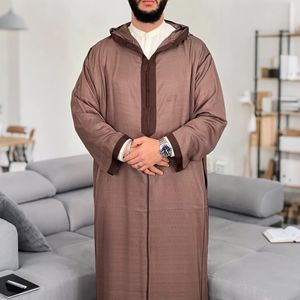- Published on
The Djellaba Versatility and Cultural Identity
- Authors

- Name
- Adil ABBADI
Introduction
The djellaba, a ubiquitous figure in Moroccan streets, markets, and celebrations, is more than just a traditional garment. It is a symbol of Moroccan identity, a reflection of the country's rich cultural heritage, and an embodiment of its people's resilience and adaptability. The djellaba's significance, from its historical roots to its contemporary relevance, is a testament to the power of tradition in shaping a nation's character.
Historical Context
The djellaba's origins date back to the 16th century, when Morocco was under Ottoman rule. The garment was initially worn by the aristocracy and later adopted by the general population. Over time, the djellaba evolved, incorporating various cultural influences, from the Arab, Berber, and European styles. This cultural fusion is evident in the djellaba's design, which features intricate embroidery, delicate patterns, and vibrant colors.
Traditional Significance
In Moroccan culture, the djellaba is a symbol of modesty, and dignity. It is often worn during special events, like weddings, Eid celebrations, and other important ceremonies. The djellaba is also a staple in everyday life, particularly in rural areas, where it serves as a practical and comfortable garment for daily activities. In addition, the djellaba is a symbol of national pride, reflecting Morocco's history, traditions, and values.
Modern Relevance
In recent years, the djellaba has experienced a resurgence in popularity, particularly among young Moroccans. The garment has been reimagined, incorporating modern materials, styles, and designs, while maintaining its cultural essence. This revival is a testament to the djellaba's timeless appeal, as well as the growing interest in preserving traditional practices and cultural heritage.
Cultural Preservation
Efforts to preserve and promote the djellaba's cultural significance are underway. The Moroccan government, in collaboration with local artisans and designers, has launched initiatives aimed at preserving traditional craftsmanship and promoting the djellaba-making techniques. Additionally, fashion designers are incorporating the djellaba into their collections, blending traditional styles with modern twists, ensuring the djellaba's continued relevance in contemporary Moroccan culture.

Conclusion
The djellaba is an integral part of Moroccan cultural identity, a testament to the country's rich heritage and versatility. As a symbol of tradition, the djellaba continues to inspire and influence contemporary Moroccan culture, transcending generations and cultural boundaries.
Cultural Call-to-Action
As we celebrate the djellaba's cultural significance, let us also acknowledge the artisans, designers, and everyday Moroccans who have contributed to its enduring legacy. Let us continue to appreciate and learn from this rich cultural heritage, embracing the djellaba as a symbol of Moroccan identity and a testament to the power of tradition.
